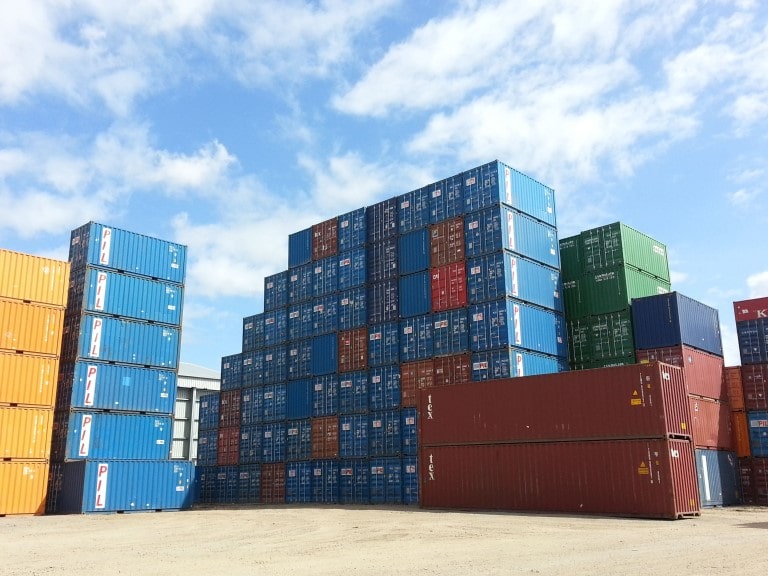Have you ever wondered how shipping containers survive their long ocean journeys without tipping over and falling into the water? The old-fashioned way was to strap the cargo down with ropes and hope for the best. But today, shipping containers use specially designed twist locks to secure up to 12 containers high. At Gateway, we stack containers seven high.
You need to know how to lock shipping containers together when it comes to container homes too. Standard practice requires your shipping container to stay firmly fixed on the ground, even more so for containers installed side by side or stacked up.
Learn all about how to lock shipping containers together below.
What is a Shipping Container Lock?
Shipping container locks are mainly locked using twist locks, called as such because of their mechanism: you rotate a lever either to the right or left to lock or unlock it. While most container twist locks are manual, there are semi-automatic twist locks and fully automatic twist locks.
Whichever you choose, twist locks stay secured by the weight of the container. As soon as the locks are in place, the pressure makes the containers immovable when they’re in transit on a ship, truck, train, or installed as a container home.
How a Shipping Container Lock Works
Shipping container twist locks work hand in hand with corner castings, which are the three-holed corners of your shipping container. Castings connect containers vertically and horizontally to allow for stacking and transportation.
At Gateway, our container castings are cast steel, and they’re welded into the shipping container. There are two sets each for the top and bottom of your container: top left, top right, bottom left, and bottom right.
Castings withstand the pressure from stacking and lifting and temperature and moisture changes.
Sometimes old or used shipping containers need new castings before adding twist locks. Once you ensure your castings are up to standard, install your twist lock easily, as this video explains.
The locks appear loose, but remember that this is before you install the top or adjacent container—the weight will lock it in place.
Twist locks are usually left-to-right; the locking lever is open when on the left and locked when on the right. Place the twist-lock in the bottom casting, turn the lever to neutral to set the top casting, and then turn the lever to the right to lock it.
Note: Automatic and semi-automatic container locks are spring-loaded, so they engage as soon as the container weight reaches a given threshold and release once the spring disengages.
Types of Shipping Container Locks
The main types of shipping container twist locks are either vertical or horizontal. Upright twist locks are for stacking shipping containers, one on top of the other. Horizontal twist locks secure shipping containers side by side.
Twist locks are further grouped according to their design and use. These include:
Twist Lock Fixing Plates
If you’re installing a shipping container home, shed, studio or office, the first thing you should think about is the ground surface. A fixing plate works well if you have a flat, even platform like a concrete foundation.
This type of container lock is the quickest and easiest to use since it’s bolted rather than welded onto the ground and the container. If you plan to move your container space frequently, opt for twist locks with fixing plates to make transportation easier.
Adjustable Twist-Lock Legs
You can still install your shipping container on an uneven surface using adjustable twist locks. Choose twist locks that have legs on the bottom left and bottom right castings. Most adjustable twist-lock legs adjust up to 580mm, so you can level out your container floor with little ground preparation.
Dovetail Twist Locks
Once you secure your shipping container on the ground, you may want to stack another container on top or have two containers side by side. This is where dovetail twist locks come in. Today, the dovetail design is one of the most popular twist locks since it allows for either a vertical or horizontal connection.
Twist Lock Stacking Pins
Twist-lock pins go into the castings to support vertically stacked shipping containers for extra stability. These usually have a double-ended design that connects to any standard shipping container casting.
The great thing about twist-lock stacking pins is that they can join your shipping containers at a 90-degree angle. This opens up the possibilities, such as cantilevered designs or combining different sized shipping containers for a multi-story building.
Tip: Your shipping container design must come first. Where you’ll place your container, how many containers you’ll need, how much weight they’ll carry, and how often you’ll relocate will determine the type of twist locks you’ll choose to lock your shipping containers together.
%20(1).jpg)
How to Choose Shipping Container Locks
Gateway can supply modifications and accessories for your project like shipping container locks. But if you’d like to understand more about how to lock shipping containers together, here are some tips to keep in mind.
Choose Twist Locks With Ground Plates
If you build a concrete foundation for your shipping container home, office or shed, choose a twist-lock design with a wide ground plate and bolt holes. Weld the castings on the bottom of your container, install the locks into the concrete, lower the shipping container, and lock it in place.
Secure the Locks in the Same Direction
Manual twist locks are either right-to-left or left-to-right. Choose locks that all operate in the same direction so that all the rods face one side when locked. This is especially important if you’ll be moving your container frequently. When all the operating rods are facing the same way, you can quickly verify that the container is secure just by looking at it. You won’t need to countercheck each lock manually.
Check the Twist-Lock Features
As you browse for container twist lock specifications, you’ll find information about weight, breaking loads, compression, bolt sizes, etc. All twist locks should meet ISO standards, be easy to assemble, and have shock absorbers or other protections against wear and tear.
Twist locks should also be symmetrical such that you can use them upside-down depending on your installation needs.
Inspect the Twist Locks before Use
If you’re going for used twist locks for a second-hand shipping container, always check that they are clean and lubricated. Any damage to your twist lock directly affects the safety of your shipping container. Find out if you can find replacement parts from your twist lock manufacturer or invest in brand new twist locks that will last you for decades.

How to Install a Twist Lock on a Shipping Container
Let’s look at the factors to consider before you lock shipping containers together.
Container Transportation
Think about the process of getting it from your container supplier all the way to your property. You’ll need to secure your shipping container on the truck chassis and then unload and install it onto your foundation. Of course, if you buy through Gateway we offer a delivery service. You’ll also need more twist locks for multiple shipping containers.
Castings and Foundations
Check that the castings on your shipping container are structurally intact to support the twist lock. The same goes for the foundation: install the plates on your concrete floor and ensure you set them before bringing in your shipping container.
Container Lifting
You’ll then need to lift your shipping container to install the twist locks. You can use a container lifting jack, forklift, crane or swing lift to access the bottom corners of the container.
The lifting method depends on the size and weight of your container and how many containers you need to stack up. For example, a lifting jack works great for a single container, but it won’t work for vertical stacking. On the other hand, side-by-side installation means you’ll need more clearance to move the shipping containers.
Twist Lock Installation
As mentioned above, the actual twist-lock installation is fast and easy. It should take only minutes to install all four locks at the bottom of your container. Then lower the container and turn the operating rods to the right or left, depending on your twist lock choice.
Release the container, and you’re all set to begin your renovations. Repeat this process with the top corners of your container to stack them vertically.
Tip: Work with a professional shipping container company like Gateway to lock shipping containers together. Much planning goes into this, from preparing the ground surface to enough space for the crane to stack your containers and much more.
Final Thoughts
Shipping containers must transport expensive, sometimes hazardous cargo over long distances and under unpredictable conditions. This is why twist locks are such an essential part of the shipping business.

Even for container home or office setups, you must know how to lock shipping containers together, not just for safety but for design flexibility too. Let Gateway Containers sort out your shipping container needs from start to finish.
Our range of shipping containers comes with all the accessories you can think of, plus modifications to meet your unique purpose. Contact us today.




